
Down Ampney is a medium-sized village located in Cotswold district in Gloucestershire, in England. The population taken at the 2011 census was 644.
Farleigh Hungerford is a village within the civil parish of Norton St Philip in the Mendip district, in Somerset, England, 9 miles southeast of Bath, 3½ miles west of Trowbridge on A366, between Trowbridge and Radstock in the valley of the River Frome.

Sir Thomas de Hungerford of Farleigh Castle in Somerset, was the first person to be recorded in the rolls of the Parliament of England as holding the office of Speaker of the House of Commons of England, although that office had existed before his tenure.
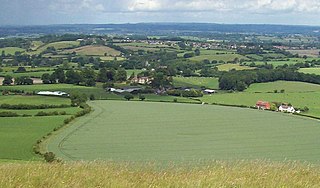
Corsley is a hamlet and civil parish 3 miles (5 km) west of Warminster in Wiltshire, England. The parish is on the county border with Somerset; the Somerset town of Frome is about 3 miles (5 km) to the northwest. The largest settlement in the parish is Corsley Heath, which is on the A362 Warminster-Frome road.

Hemington is a village and civil parish 5.5 miles (8.9 km) north west of Frome, in the Mendip district of Somerset, England. It is located just off the A366 between Trowbridge and Radstock. The parish includes the villages of Hardington, Faulkland and Foxcote.
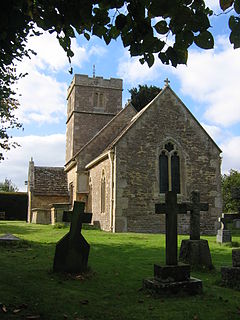
Tellisford is a village and civil parish 6 miles (10 km) north-east of Frome in the Mendip district of Somerset, England. The parish includes the village of Woolverton.
Mendip is a local government district in the English county of Somerset. The Mendip district covers a largely rural area of 285 square miles (738 km2) ranging from the Mendip Hills through on to the Somerset Levels. It has a population of approximately 11,000. The administrative centre of the district is Shepton Mallet.

The Church of St Mary the Virgin in Nettlecombe, Somerset, England dates from the 13th and 14th centuries, and has been designated as a Grade I listed building.

The Church of St Andrew & St Mary in Pitminster, Somerset, England was built around 1300 and has been designated as a Grade I listed building.
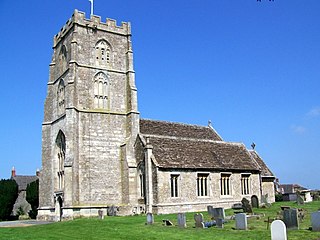
The Church of St Lawrence in Rode, Somerset, England, dates from the late 14th and early 15th century. It was restored in 1874 by Charles Edward Davis and is a Grade I listed building.

Farleigh Hungerford Castle, sometimes called Farleigh Castle or Farley Castle, is a medieval castle in Farleigh Hungerford, Somerset, England. The castle was built in two phases: the inner court was constructed between 1377 and 1383 by Sir Thomas Hungerford, who made his fortune as steward to John of Gaunt. The castle was built to a quadrangular design, already slightly old-fashioned, on the site of an existing manor house overlooking the River Frome. A deer park was attached to the castle, requiring the destruction of the nearby village. Sir Thomas's son, Sir Walter Hungerford, a knight and leading courtier to Henry V, became rich during the Hundred Years War with France and extended the castle with an additional, outer court, enclosing the parish church in the process. By Walter's death in 1449, the substantial castle was richly appointed, and its chapel decorated with murals.
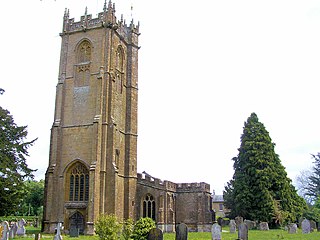
The Church of St George in Hinton St George, Somerset, England includes 13th-century work by masons of Wells Cathedral, and has been designated as a Grade I listed building.
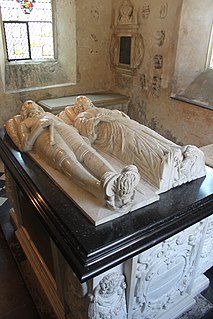
Sir Edward Hungerford (1596–1648) of Corsham, Wiltshire and of Farleigh Castle in Wiltshire, Member of Parliament, was a Parliamentarian commander during the English Civil War. He occupied and plundered Salisbury in 1643, and took Wardour and Farleigh castles.
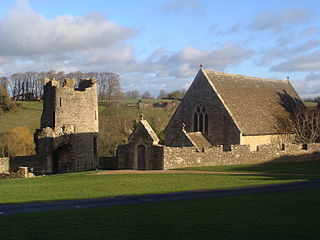
Saint George and the Dragon is a mural in the chapel of Farleigh Hungerford Castle, Somerset, England.
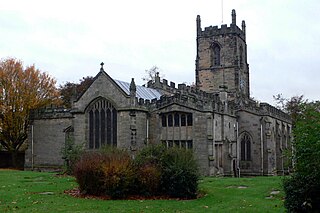
St Helen's Church is the Anglican parish church of Ashby-de-la-Zouch, in the deanery of North West Leicestershire and the Diocese of Leicester. There was a church in the town in the 11th century, but the core of the present building mainly dates from work started in 1474, when the church was rebuilt by William Hastings at the same time that he converted his neighbouring manor house into a castle. The church was refurbished in about 1670 to create more space, but the large and increasing size of the congregation led to further work in 1829, and a major rebuild in 1878–80, including the widening of the nave by the addition of two outer aisles.

The Church of St Philip and St James in Norton St Philip within the English county of Somerset is a Grade II* listed building.
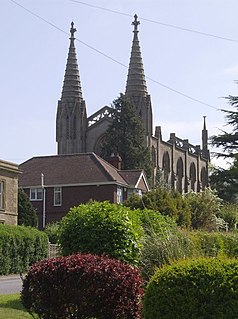
The Anglican Church of St Peter in Rode, within the English county of Somerset, dates from 1824. It is a redundant church and a Grade II* listed building.

The Anglican Church of St Mary in Laverton, Lullington, Somerset, England was built in the 11th century. It is a Grade II* listed building.

















